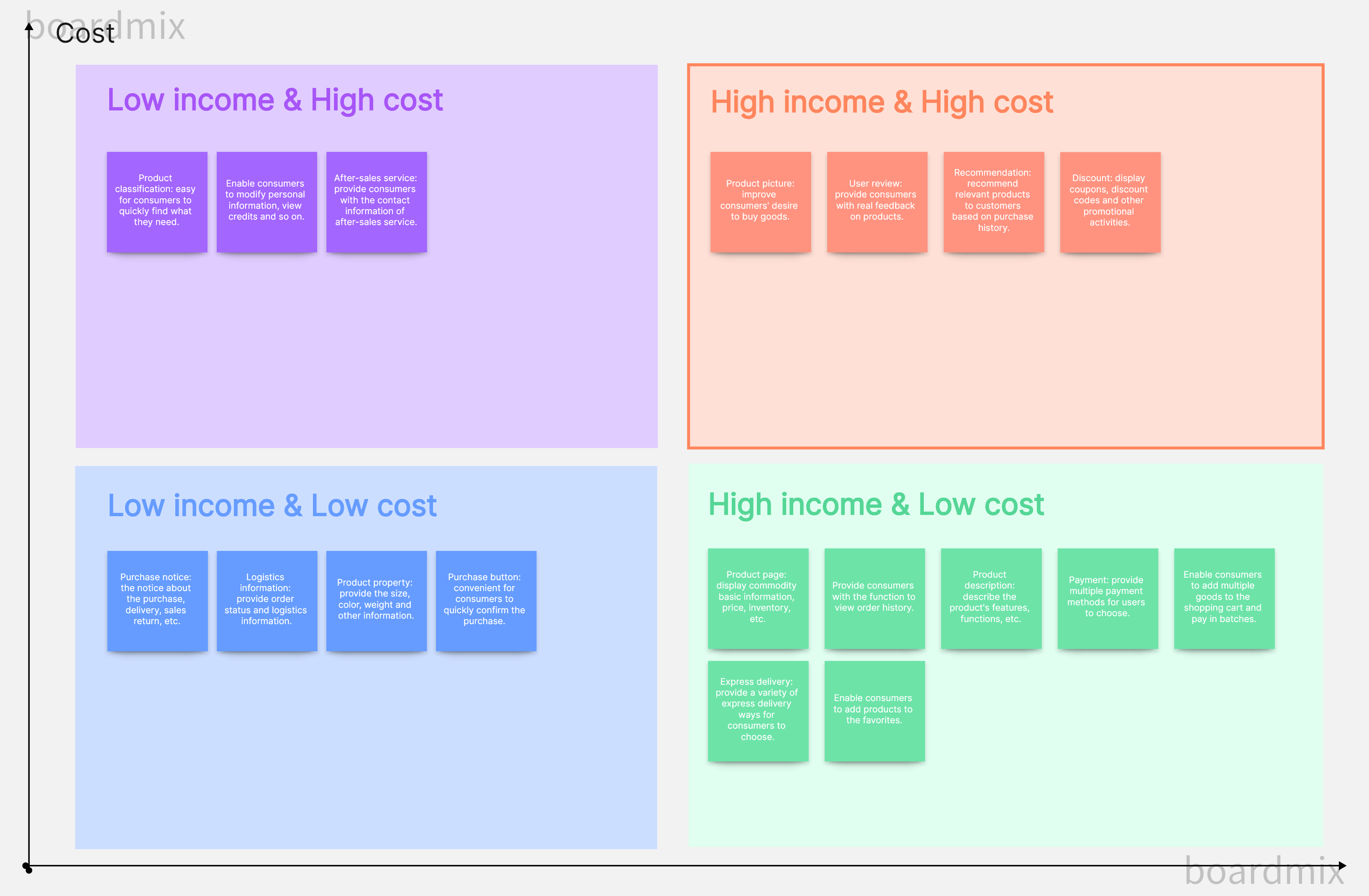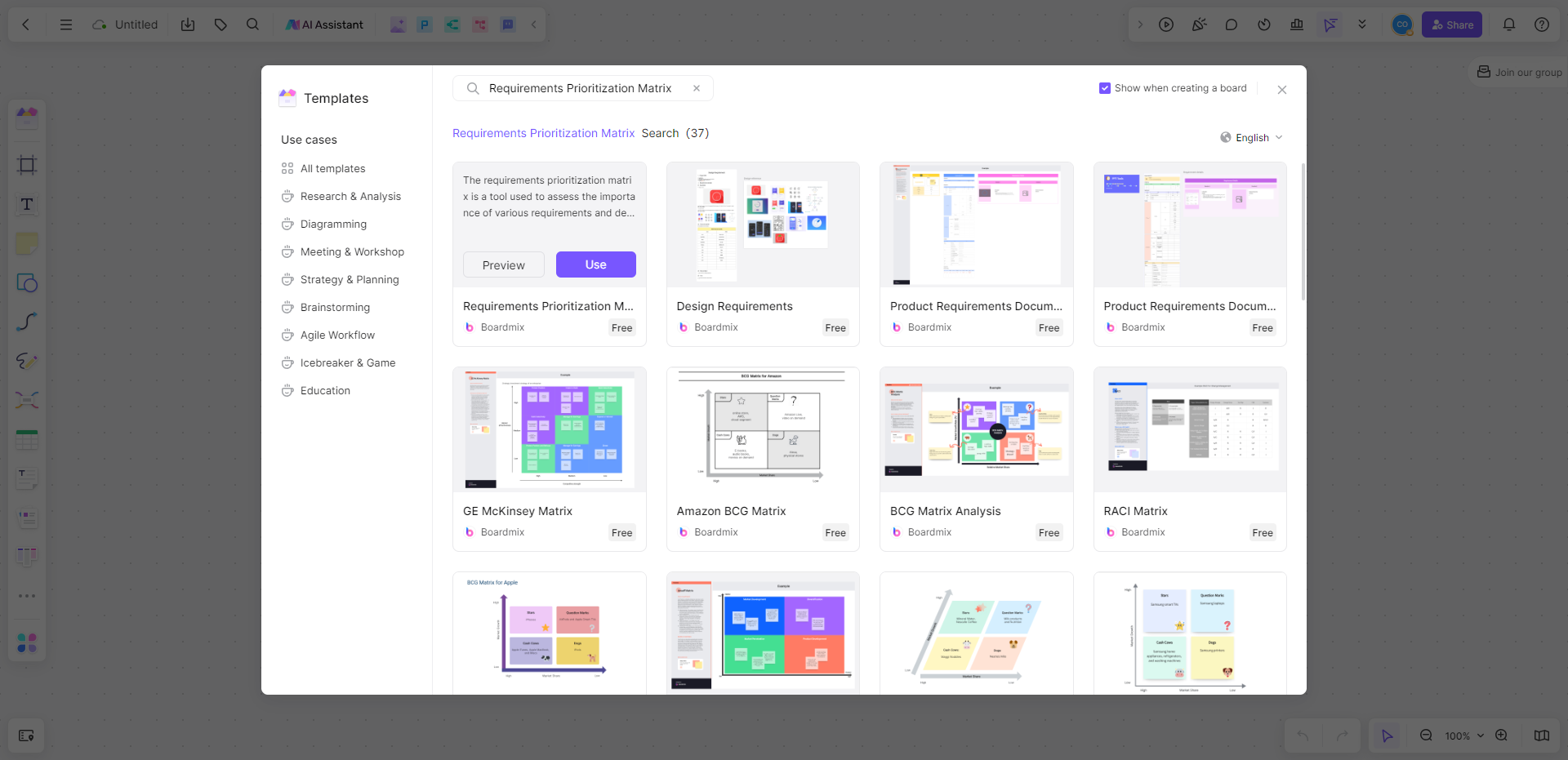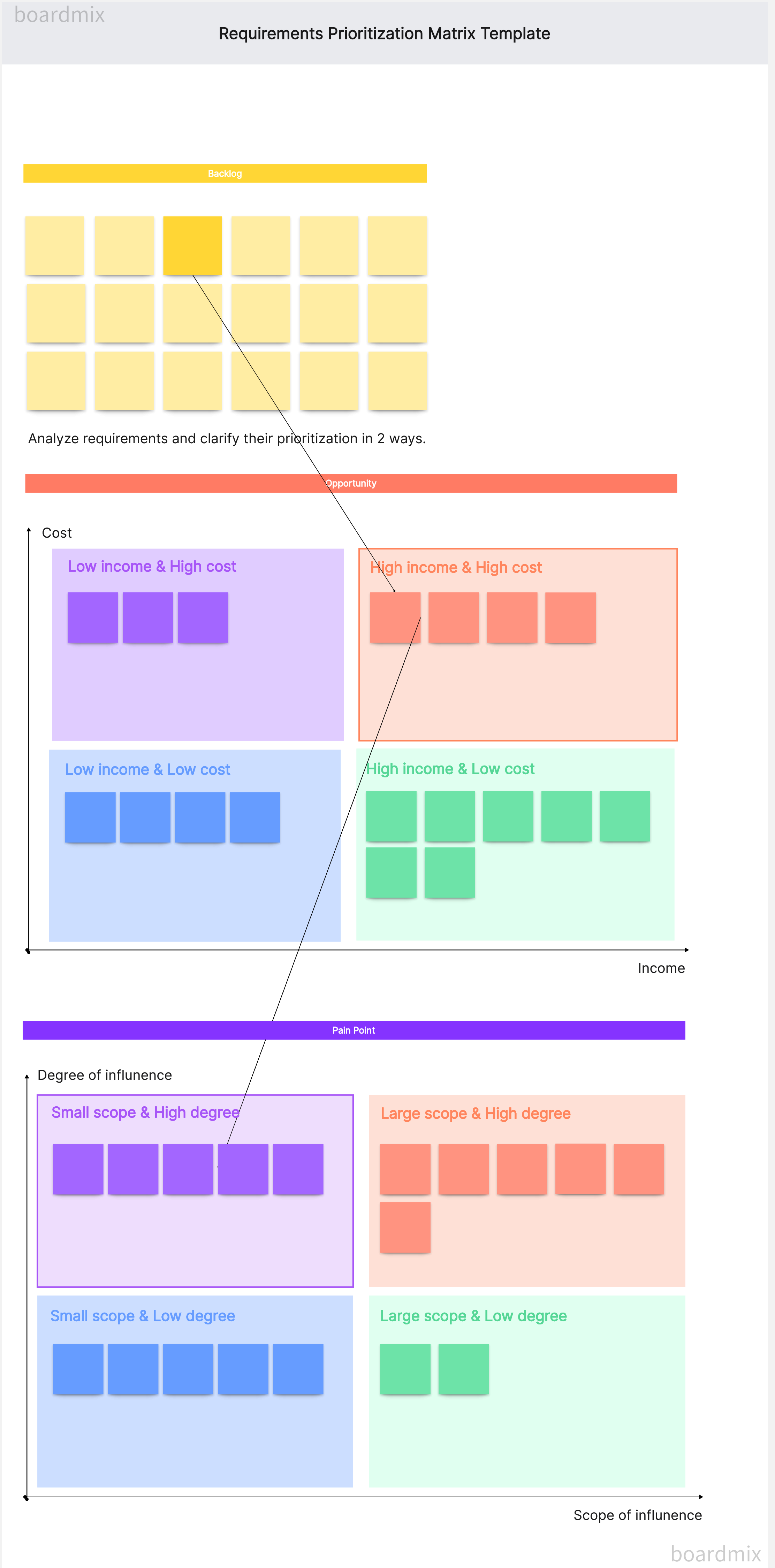Efficient project management often feels like a juggling act, balancing multiple tasks, resources, and deadlines. One tool that can make this act less daunting is the Prioritization Matrix. It's a template that allows you to rank and prioritize tasks based on their impact and urgency, ensuring your resources are optimally allocated. But how do you use this template effectively? And how can it transform your approach to project management? Let's delve into these questions together, exploring the power of the Prioritization Matrix Template and its potential to streamline your project management process.
What is the Prioritization Matrix?
The Prioritization Matrix is a decision-making tool to prioritize tasks, requirements, or options based on specific criteria. It helps individuals or teams determine which tasks or requirements are most important and should be prioritized.
The Prioritization Matrix typically consists of two axes: importance and feasibility. Importance refers to the significance or impact of the task or requirement, while feasibility refers to the practicality or ease of implementation. Each task or requirement is then plotted on the matrix based on its importance and feasibility. The Prioritization Matrix can also be customized with additional criteria depending on the specific needs of the project or organization. The Prioritization Matrix provides a more comprehensive view of task or requirement prioritization by considering multiple criteria.
Overall, the Prioritization Matrix is a valuable tool for decision-making, ensuring that tasks or requirements are prioritized based on their importance and feasibility.

When to Use the Priority Matrix Template?
The Priority Matrix Template, while a simple tool, can be a powerful ally in your project management arsenal. But when exactly should you utilize it? The answer is - at any stage of your project clarity and focus are required. Whether you're in the initial planning phase, trying to sort through a myriad of tasks, or amid execution, grappling with shifting priorities - the Priority Matrix Template can be your guiding light. The priority matrix template can play a huge role in many scenarios.
1. Project Management
When you are managing a project and need to balance various requirements and tasks, the priority matrix template can help you determine which tasks are most important and which tasks should be performed first. By setting clear priorities, resources can be allocated more effectively, reducing project risk.
2. Decision Making
When complex decisions need to be made, the priority matrix template can help you quantify the advantages and disadvantages of each option, providing a more scientific and objective basis for decision-making. It can help you avoid decision bias and make better decisions.
3. Product Development
In product development, the priority matrix template can help you determine which features should be developed first. By taking into account factors such as customer needs, development costs, competitor situations, etc., product development can be more in line with market needs.
4. Risk Management
In risk management, the priority matrix template can help you identify and assess various potential risks. Through quantitative analysis of the likelihood and impact of risks, more effective risk response strategies can be formulated.
The above are all situations where the priority matrix template can come in handy. However, this is not all. Whenever you need to sort out a series of matters and set priorities, the priority matrix template can assist.
How to Use the Priority Matrix Template Effectively?
Using a Priority Matrix Template effectively can be a game-changer in your project management strategy. It's like having a compass in hand, guiding you through the labyrinth of tasks, and helping you zero in on what truly matters. Using the Priority Matrix Template effectively involves following a few key steps.
1. Define your criteria
Start by identifying the specific criteria or factors that are important for prioritizing your tasks, requirements, or options. This could include factors such as urgency, impact, cost, feasibility, or strategic alignment. Be sure to choose criteria that are relevant to your specific project or goals.
2. Assign weights
Once you have identified your criteria, assign weights to each criterion to reflect their relative importance. This will help you prioritize and compare different tasks or requirements based on their importance.
3. Evaluate tasks or requirements
For each task or requirement, evaluate and assign a score or rating for each criterion based on its alignment with that criterion. This can be done on a scale, such as 1 to 5, with 1 being low and 5 being high.
4. Calculate the total score
Multiply the assigned score for each criterion by its weight, and then sum up the weighted scores for each task or requirement. This will give you a total score for each task or requirement.
5. Plot on the matrix
Using the Priority Matrix Template, plot each task or requirement on the matrix based on its total score. The matrix typically consists of four quadrants: high priority and high feasibility, high priority and low feasibility, low priority and high feasibility, and low priority and low feasibility.
6. Analyze and prioritize
Analyze the distribution of tasks or requirements on the matrix and identify those that fall in the high priority and high feasibility quadrant. These tasks or requirements should be given the highest priority. Adjust your resource allocation and decision-making accordingly.
7. Review and update
Regularly review and update your Priority Matrix as new tasks or requirements arise or as priorities change. This will ensure that your resource allocation remains aligned with your project goals.
By following these steps and utilizing the Priority Matrix Template effectively, you can make informed decisions about task or requirement prioritization and effectively allocate your resources.

Why Prioritization Matrix is Important?
The Prioritization Matrix is important because it provides a systematic approach to prioritizing tasks, requirements, or options based on specific criteria. By using this tool, individuals or teams can make more informed decisions about resource allocation and task prioritization. Here are some reasons why the Prioritization Matrix is important:
1. Effective resource allocation
The matrix allows individuals or teams to visually see the distribution of tasks or requirements and identify those that have high importance and feasibility. This helps in allocating resources effectively by focusing on tasks that have the highest priority.
2. Decision-making
The matrix provides a framework for decision-making by considering multiple criteria. By evaluating tasks or requirements based on their importance and feasibility, individuals or teams can prioritize those that align with their goals or objectives.
3. Time management
The matrix helps in managing time effectively by prioritizing tasks that have a higher impact or urgency. It allows individuals or teams to focus on tasks that need immediate attention, reducing the chances of missing deadlines or important milestones.
4. Strategic planning
The matrix can be customized with additional criteria depending on the specific needs of the project or organization. This helps in aligning tasks or requirements with strategic objectives, ensuring that resources are allocated to projects that contribute to long-term goals.
5. Collaboration and communication
The matrix provides a visual representation of task prioritization, making it easier for team members to understand and discuss priorities. It facilitates collaboration and communication within the team, ensuring that everyone is on the same page regarding task importance and feasibility.
Overall, the Prioritization Matrix is important because it helps in making informed decisions, optimizing resource allocation, and aligning tasks with strategic objectives. It is a valuable tool for effective project management and decision-making.
What are the benefits of Using a Priority Matrix Template?
A Priority Matrix Template, a seemingly simple tool, can be a game-changer in your project management strategy. It's like having a compass guiding you through the maze of tasks, helping you identify what truly matters. This template is designed to help you rank and prioritize tasks based on their impact and urgency, ensuring optimal allocation of resources. Using a Priority Matrix Template offers several benefits.
1. Easy organization
A Priority Matrix Template provides a structured format for organizing tasks or requirements based on their importance and feasibility. It allows individuals or teams to visually see the priorities and easily track progress.
2. Efficient decision-making
With a Priority Matrix Template, individuals or teams can evaluate tasks or requirements based on predefined criteria and make informed decisions. It helps in identifying tasks that have high impact and feasibility, enabling better resource allocation and task prioritization.
3. Time management
The template helps in managing time effectively by highlighting tasks that need immediate attention. It allows individuals or teams to focus on tasks that are both important and urgent, reducing the chances of missing deadlines or important milestones.
4. Collaboration and communication
A Priority Matrix Template provides a common framework for discussing priorities and facilitates collaboration among team members. It ensures that everyone is on the same page regarding task importance and feasibility, promoting effective communication within the team.
5. Goal alignment
The template can be customized to align with specific goals or objectives of the project or organization. It helps in prioritizing tasks that contribute to long-term goals and strategic objectives, ensuring that resources are allocated to projects that have the greatest impact.
6. Tracking progress
With a Priority Matrix Template, individuals or teams can track the progress of tasks and monitor their completion. It provides a visual representation of task prioritization, making it easier to identify tasks that are lagging behind or need additional attention.
Overall, using a Priority Matrix Template enhances organization, decision-making, time management, collaboration, goal alignment, and progress tracking. It is a valuable tool for individuals and teams seeking to prioritize tasks effectively and achieve project success.
Boardmix: Manage Project Effectively with the Priority Matrix Template
Boardmix is an online project management platform that incorporates the use of the Priority Matrix Template to help teams manage projects effectively. With Boardmix, you can easily create and customize your priority matrix, assign tasks to team members, track progress, and collaborate in real time. The platform also offers features such as file sharing, chat functionality, and analytics to streamline project management processes.

By using Boardmix's Priority Matrix Template, you can enhance your team's productivity, improve communication, and ensure that everyone is aligned with project goals and priorities. Whether you are working on a small team or managing large-scale projects, Boardmix provides the tools you need to stay organized, make informed decisions, and achieve project success.

In conclusion, utilizing a Priority Matrix Template through platforms like Boardmix can significantly improve your project management capabilities. By effectively organizing tasks, making informed decisions, managing time efficiently, promoting collaboration, aligning with goals, tracking progress, and adapting to changing circumstances, you can ensure the success of your projects. So why not give it a try and experience the benefits firsthand?
FAQ of Prioritization Matrix
What is the 2x2 matrix for prioritization?
The 2x2 matrix for prioritization is a tool used to assess and prioritize tasks or projects based on their urgency and importance. It consists of four quadrants:
- Quadrant 1: Urgent and Important),
- Quadrant 2: Important but not Urgent)
- Quadrant 3: Urgent but not Important)
- Quadrant 4: Not Urgent and Not Important)
By using the 2x2 matrix, you can prioritize your tasks based on their urgency and importance, helping you make better decisions and allocate your time and resources more effectively.
What is the 3x3 prioritization method?
The 3x3 prioritization method is a tool used to assess and prioritize tasks or projects based on three criteria: urgency, importance, and effort. It consists of a grid with three columns representing each criterion and three rows representing different levels.
In this method, tasks or projects are assigned a score or rating for each criterion on a scale of 1 to 3, with 1 being the lowest and 3 being the highest. The scores are then multiplied together to calculate the total score for each task.
How Do I Make a Priority Plan?
To make a priority plan, follow these steps:
- Identify and list your tasks: Start by making a list of all the tasks or activities that you need to accomplish. This can include both personal and professional tasks.
- Determine task importance: Evaluate each task and determine its importance or significance. Consider factors such as deadlines, impact on goals, and potential consequences of not completing the task.
- Assess task urgency: Next, assess the urgency of each task. Determine which tasks require immediate attention and which ones can be postponed or delegated.
- Prioritize tasks: Based on the importance and urgency of each task, prioritize them accordingly. Use a prioritization system such as a priority matrix or a numbering system to rank the tasks.
- Allocate resources: Consider the resources needed to complete each task, such as time, money, and manpower. Allocate resources based on the priority of the tasks.
- Set deadlines: Assign deadlines to each task to create a sense of urgency and ensure timely completion.
- Create a schedule: Once you have prioritized your tasks and set deadlines, create a schedule or a to-do list that outlines when each task will be completed. This will help you stay organized and focused.
- Review and adjust: Regularly review your priority plan and make adjustments as needed. As new tasks or priorities arise, reassess their importance and adjust your plan accordingly.
Remember, making a priority plan is a dynamic process. It requires regular evaluation and adjustment based on changing circumstances and priorities.













